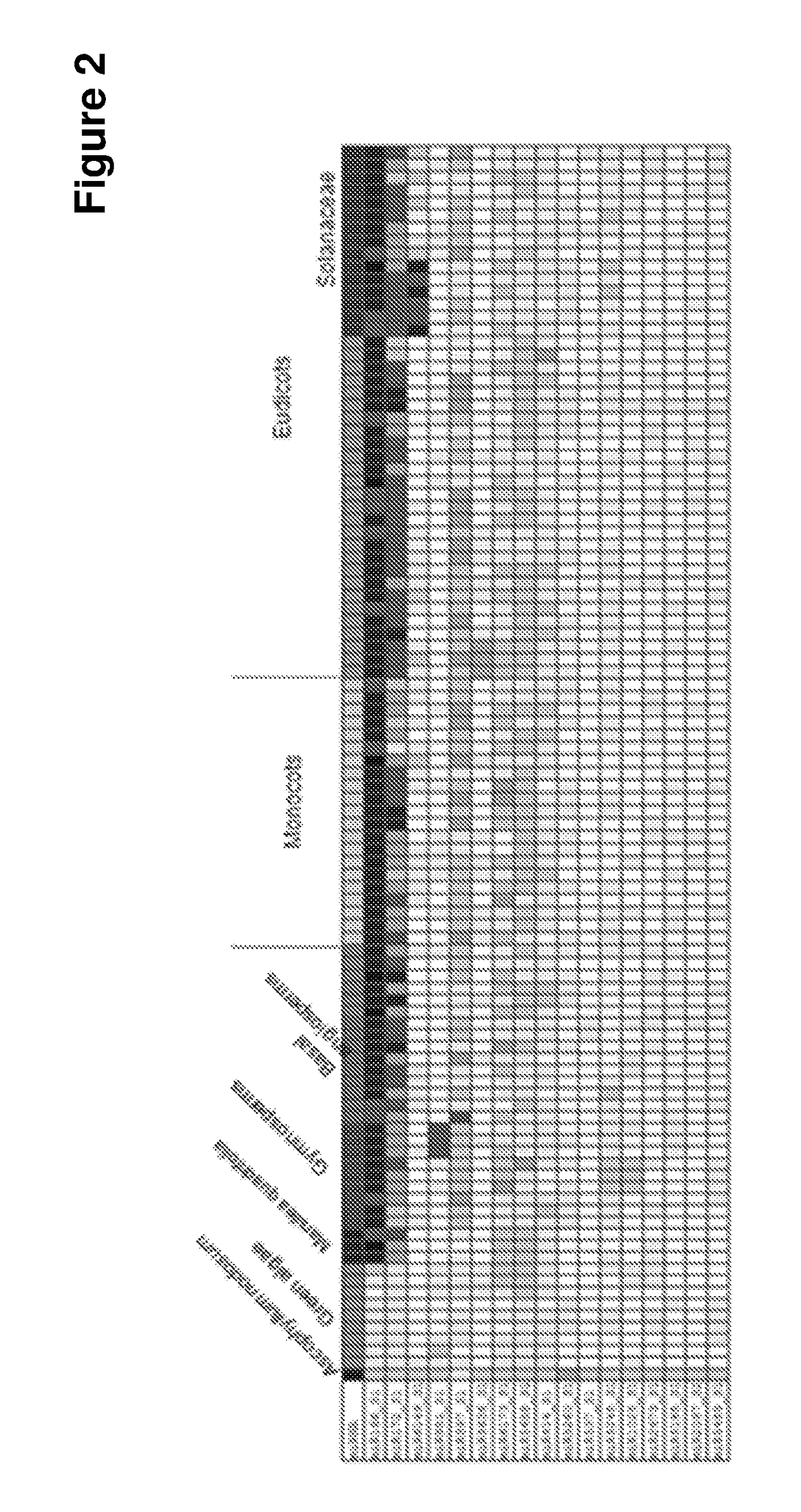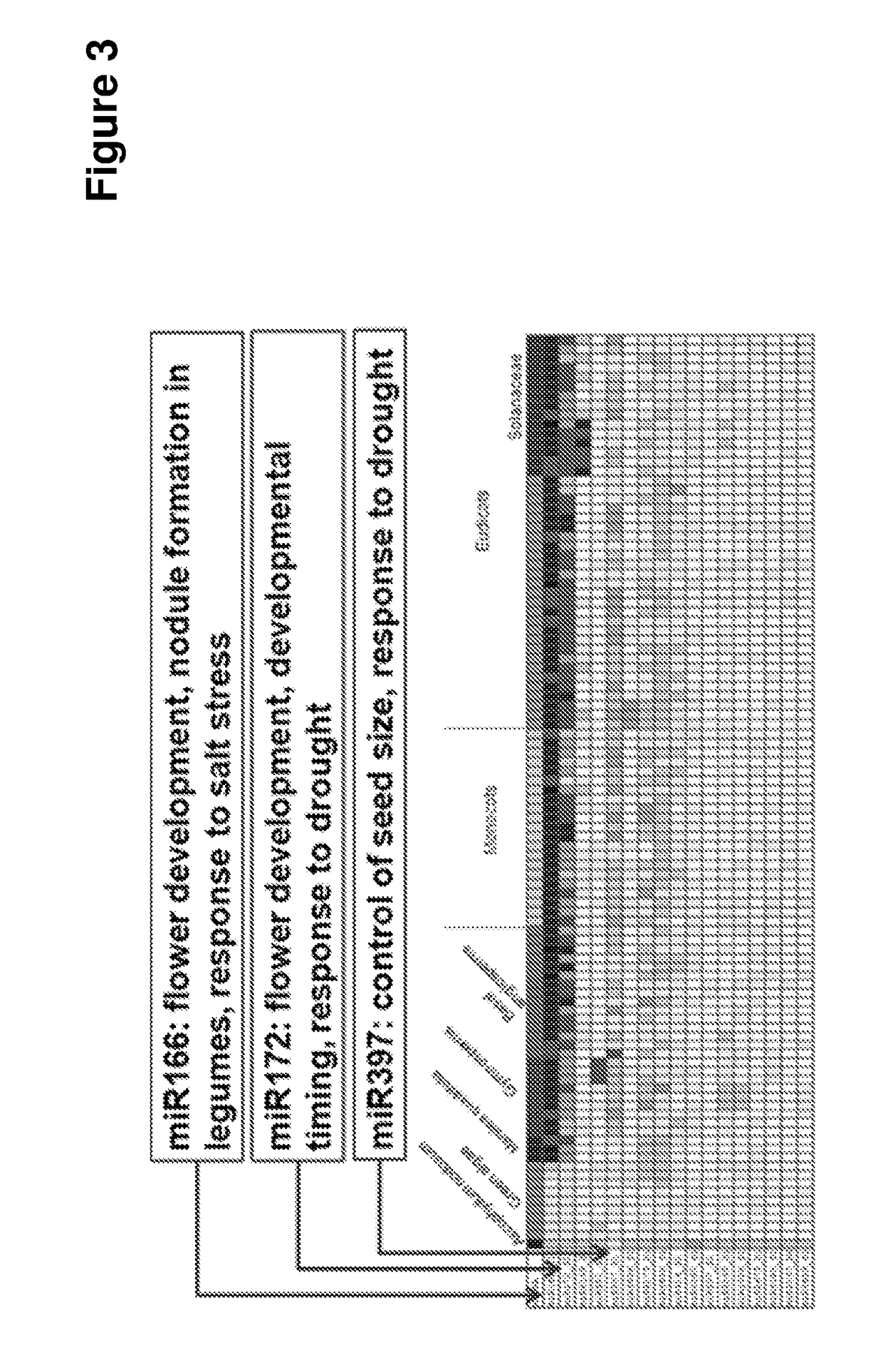Method for modulating plant processes
a plant process and process technology, applied in the field of plant process modulation, can solve the problems of many long-term environmental consequences, resource depletion, health effects, etc., and achieve the effect of improving nutrient uptake, increasing plant yield and fruit and/or flower quality
- Summary
- Abstract
- Description
- Claims
- Application Information
AI Technical Summary
Benefits of technology
Problems solved by technology
Method used
Image
Examples
example i
[0077]Extraction and Characterization of the Ascophyllum Nodosum miRNAs
[0078]Ascophyllum nodosum small RNA was extracted by 100 mg of algae samples (previously stored at −80° C.) with mirPremier microRNA Isolation Kit (Sigma-Aldrich).
[0079]Purified small RNA samples were analyzed by 4% agarose gel electrophoresis and the quality was checked by a BioAnalyser.
[0080]Since most of the mature miRNAs have a 3′-hydroxyl group as a result of the enzymatic cleavage by Dicer or other RNA processing enzymes, we used the TruSeq Small RNA Sample Preparation Kit (Illumina) to prepare a miRNA library. This technology uses a 3′ adapter specifically modified to target microRNAs and other small RNAs that have a 3′ hydroxyl group. Next, the isolated miRNA were sequenced using the HiSeq 2000 platform (IGA Technology Service, Udine).
[0081]The obtained sequences were then cleaned removing adaptor / acceptor sequences. A total of 27,152,631 reads was obtained that produced 2,117,202 unique miRNA. The occurr...
example ii
[0092]Plant Release of miRNAs.
[0093]In order to verify if a plant is able to release miRNAs, a hydroponic system was used. In particular, Arabidopsis plants were grown in a growth chamber at 23° C. with a 12 / 12 photoperiod. The light intensity was 100 micromole photons m−2 s−2 (as described by Gibeaut et al. 1997, Plant Physiol., 115: 317-319) and miRNA399d was detected in the external growing medium.
[0094]The analysis has been carried out by using an RT-PCR methodology, coupled with the quantitative PCR detection of miR399d, pre-miR399d, the RNA sequences rRNA 40S and GAPDH.
[0095]A stem-loop RT procedure followed by sybr-green PCR analysis was used to amplify the miR399 sequence. The results shown in FIG. 5 clearly show that pre-miR399 as well as the mature miR399 sequences was detected in the external growing medium, while the other, single-stranded RNA sequences were not detectable.
[0096]These results strongly suggest that miRNA can be released from Arabidopsis roots and they sup...
example iii
[0103]Co-Cultivation of Arabidopsis Plants Overexpressing miR399d Results in Silencing of the Target Gene (PHO2) in Nearby Wild-Type Plants.
[0104]In order to understand if exogenous miRNAs can affect the expression of the target gene in a plant that is not the one producing it, we set-up an experiment in which wild-type Arabidopsis plants (FIG. 7A) and plants overexpressing the miR399d gene (OE-miR399d-FIG. 7B) were grown separately using a hydroponic system.
[0105]The composition of the hydroponic solution is reported in Table I.
TABLE IMacronutrientsKNO31.25mMCa(NO3)21.50mMMgSO40.75mMKH2PO40.50mMMicronutrientsKCl50μMH3BO350μMMnSO410μMCuSO41.5μMZnSO42μMFe-EDTA72μM
[0106]A group of plants was co-cultivated in the same tray. Thus, the miRNAs eventually leaking from the OE-miR399d plants can reach the root system of the wild-type plants (FIG. 7C). Therefore, if the miRNAs produced by the OE-miR399d be taken-up by the wild-type plants, one should expect that the expression of the PHO2 gen...
PUM
| Property | Measurement | Unit |
|---|---|---|
| pH | aaaaa | aaaaa |
| temperature | aaaaa | aaaaa |
| abiotic stress tolerance | aaaaa | aaaaa |
Abstract
Description
Claims
Application Information
 Login to View More
Login to View More - R&D
- Intellectual Property
- Life Sciences
- Materials
- Tech Scout
- Unparalleled Data Quality
- Higher Quality Content
- 60% Fewer Hallucinations
Browse by: Latest US Patents, China's latest patents, Technical Efficacy Thesaurus, Application Domain, Technology Topic, Popular Technical Reports.
© 2025 PatSnap. All rights reserved.Legal|Privacy policy|Modern Slavery Act Transparency Statement|Sitemap|About US| Contact US: help@patsnap.com



